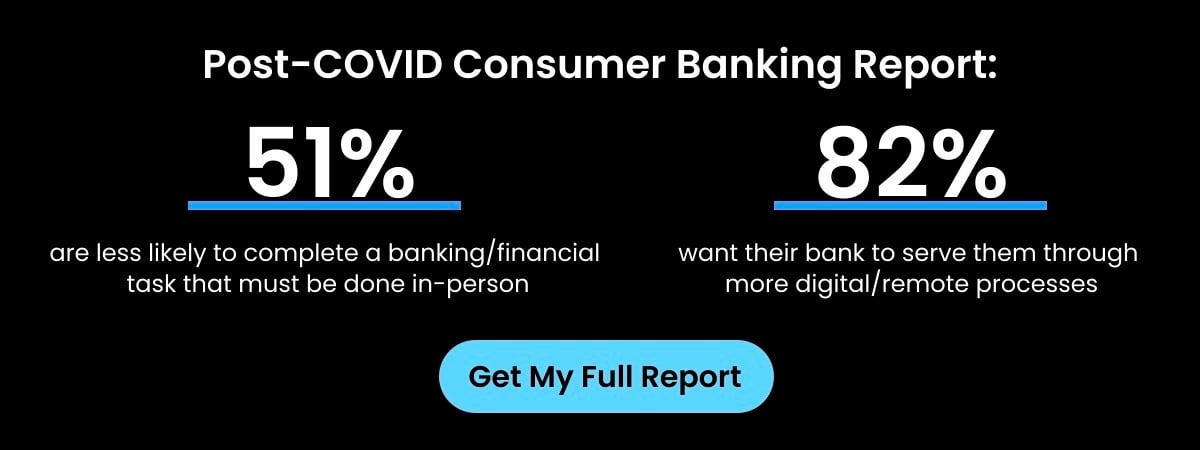Banks certainly have their hands full in light of the novel coronavirus outbreak (COVID-19). Borrowers and businesses face job losses, slowed sales, and declining profits as the virus continues to spread around the world. Banking customers are likely to start seeking financial relief, and
federal bank regulators in the U.S. are encouraging banks to help them.
In addition to managing the direct economic impact of the coronavirus, banks need to have a plan in place to protect employees and customers from its spread. Many banks are already starting to encourage remote working of some employees.
Customers, who are increasingly wary of spending time in crowded public spaces, will need to have a way to conduct banking without physical interaction. By implementing completely digitized and remote
customer transactions, banks can ensure that both everyday and exceptional processes will be carried out with limited disruption.
Coronavirus challenges traditional banking habits
As community spread of the coronavirus (COVID-19) proliferates, alternatives to in-person banking and physical exchanges are looking more and more attractive.
For example, the World Health Organization (WHO) has advised people to use
contactless payment and avoid handling banknotes as much as possible. That’s because the coronavirus may continue to live on banknotes for days, accelerating spread of the disease.
The
Bank of Korea has started to quarantine bills originating from local banks, keeping them isolated for up to two weeks. Likewise, the Chinese government requested lenders to disinfect physical notes and place them in quarantine. The U.S. Federal Reserve has instituted a practice to isolate banknotes from Asia for seven to ten days.
Of course, it’s not just paper money that’s increasingly being viewed and treated as a potential coronavirus carrier. Banks, consumers, and governments are weighing the risks of in-person banking, and opting for digital channels when they have the choice.

Current
official recommendations from the
Centers for Disease Control and Prevention advise individuals to stay six feet away from visibly sick people. This may be all but impossible at physical branches, where long lines and close interactions with bankers are expected. All it takes is one infected person to sneeze or cough to put everyone else around them at risk.
Moreover, some people may be capable of spreading the disease even before they show symptoms of illness, making avoidance of disease nearly impossible. Elderly consumers and consumers with preexisting conditions will likely be the first to avoid physical branches, as the coronavirus poses a direct threat to their life. Consumers under quarantine will literally have no choice but to forgo the branch visit.
As more cases inevitably appear across the U.S. and the world at large, physical banking will look less appealing for everyone, not just the most vulnerable populations.
Coronavirus is fueling the movement towards digital banking
Government agencies and banks are anticipating this shift towards
digital banking, and taking relevant measures. Last week, the
Federal Financial Institutions Examination Council ordered U.S. banks to test their online systems’ capacity to handle an influx of
digital banking demands. The agency called for “increased reliance on online banking, telephone banking, and
call center services” in addition to remote working.
Goldman Sachs traders are reported to have done just that, as traders are testing out working from home. HSBC has implemented split-site working arrangements in their Asia offices after an employee came down with the virus.
Singapore’s DBS
bank may provide a template for what
branchless banking could look like in our coronavirus reality. When the
bank was forced to evacuate its staff after an employee was diagnosed with the virus, DBS hunkered down to provide customers with a robust
digital banking system.
It has digitized 11 financing processes to reduce the need for in-person exchanges, and is offering business accounts instant interbank fund transfers. The
bank is also running webinars to train its staff on how to use digital tools.
In addition, SMEs can apply online for a short-term loan of up to S$50,000 to soften the blow of reduced sales and cash flow.
While the coronavirus is making the need for
digital banking services more urgent, consumers’ growing preference for digitization is nothing new. Neither is their frustration with the broken digital journeys they frequently encounter when attempting to complete an online process.
According to a recent Lightico survey, 56% of banking consumers report that they have been redirected from
online banking interactions to physical locations. And 48% say they’ve been asked to print, sign, and email papers while banking online.
The rise of digital giants such as Amazon and Netflix has primed consumers to expect satisfying and complete online interactions in all areas of their life, including banking. The coronavirus has just served to intensify people’s desire for digital
services, turning it into a matter of urgency.
Alleviate banking customers’ fears with digital-only transactions
Banks that are committed to preserving their profit margins, continuing business as usual, and reassuring anxious customers would benefit significantly from using a digital front-end platform.
Lightico’s
solution for banking enables
bank agents to easily send clients a text message link, allowing them to complete forms, submit documents, upload ID, and sign via
eSignature entirely through their mobile device.
Meanwhile,
bank agents provide real-time guidance by phone, helping customers accurately complete the entire process (and providing much-needed information and reassurance during these uncertain times).
Customers no longer have to pay a potentially stress-inducing visit to a physical branch to complete any number of transactions, from opening an account to applying for a loan.
Even after the coronavirus passes, digital solutions for banks will have an enduring relevance. The growing popularity of
neobanks and fintechs are a testament to that. Traditional banks that choose to learn and take lessons from digital financial institutions will find themselves more prepared to compete with challenger banks both during the coronavirus pandemic and long after it’s over.

 Current official recommendations from the Centers for Disease Control and Prevention advise individuals to stay six feet away from visibly sick people. This may be all but impossible at physical branches, where long lines and close interactions with bankers are expected. All it takes is one infected person to sneeze or cough to put everyone else around them at risk.
Moreover, some people may be capable of spreading the disease even before they show symptoms of illness, making avoidance of disease nearly impossible. Elderly consumers and consumers with preexisting conditions will likely be the first to avoid physical branches, as the coronavirus poses a direct threat to their life. Consumers under quarantine will literally have no choice but to forgo the branch visit.
As more cases inevitably appear across the U.S. and the world at large, physical banking will look less appealing for everyone, not just the most vulnerable populations.
Current official recommendations from the Centers for Disease Control and Prevention advise individuals to stay six feet away from visibly sick people. This may be all but impossible at physical branches, where long lines and close interactions with bankers are expected. All it takes is one infected person to sneeze or cough to put everyone else around them at risk.
Moreover, some people may be capable of spreading the disease even before they show symptoms of illness, making avoidance of disease nearly impossible. Elderly consumers and consumers with preexisting conditions will likely be the first to avoid physical branches, as the coronavirus poses a direct threat to their life. Consumers under quarantine will literally have no choice but to forgo the branch visit.
As more cases inevitably appear across the U.S. and the world at large, physical banking will look less appealing for everyone, not just the most vulnerable populations.




